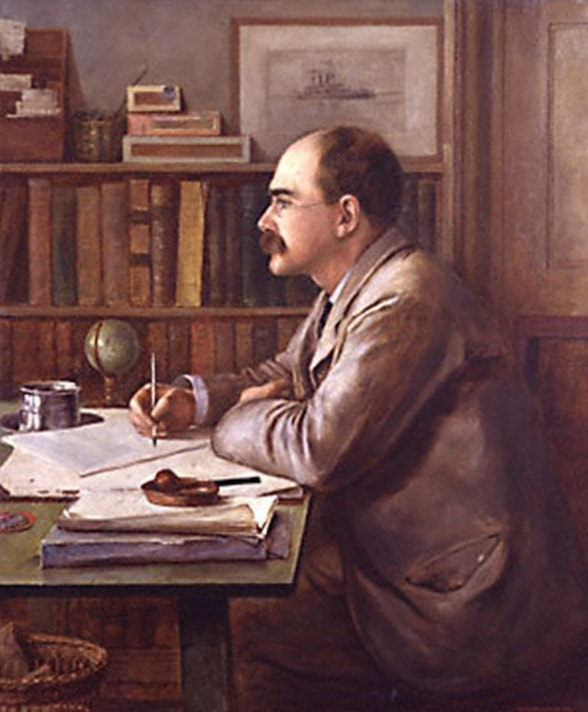Today in Kimberley's History
|
|
|
|
Rudyard Kipling born in India in 1865
Born 30 December 1865, RUDYARD KIPLING, Indian-English author and poet, Nobel Prize laureate – remembered in the naming of a CRATER and a CRETACEOUS CROCODILE. Kipling’s KIMBERLEY CONNECTIONS are in the inscription he was commissioned to write for the HONOURED DEAD MEMORIAL; and a passing reference in one of his famous “JUST SO STORIES”.
Kipling visited South Africa in 1900-1901 and for a very brief time worked as a newspaper correspondent for “The Friend” in Bloemfontein (his two-week stint there resulted in lifelong friendships with authors Perceval Landon and H. A. Gwynne).
Renowned for his “Jungle Stories”, “Kim”, “Just so stories”, and much else, Kipling was a prolific author whose legacy is today controversial. Indian politician and writer Sashi Tharoor characterised him as "that flatulent voice of Victorian imperialism.”
George Orwell similarly referred to him as a “jingo imperialist” - "morally insensitive and aesthetically disgusting…", but observed that while Kipling’s work had many qualities ensuring that "every enlightened person has despised him... nine-tenths of those enlightened persons are forgotten and Kipling is in some sense still there." Kipling “dealt largely in platitudes,” Orwell added, “and since we live in a world of platitudes, much of what he said sticks.”
In the twenty-first century Kipling’s still classic books and stories remain popular and feature in film, musical and other adaptations. But add now a CRATER and a CROCODILE through which Kipling’s memory is perpetuated.
• In 2010, the International Astronomical Union approved the naming of a crater on the planet Mercury after Kipling – one of ten newly discovered impact craters observed by the MESSENGER spacecraft in 2008–2009. Kipling's company amongst the 414 named craters on Mercury include (in no particular order) Imhotep, Gordimer, Mofolo, Bartók, Schönberg, Scarlatti, Brontë, Chekhov, Mark Twain, Ellington, Balanchine, Brahms, Rachmaninov...
• And in 2012, an extinct species of CROCODILE, Goniopholis kiplingi, was named in his honour "in recognition for his enthusiasm for natural sciences." The 130-million-year-old Goniopholis kiplingi specimen was found in Swanage, Dorset, England, where new finds continue to show up along an eroding coastline. The crocodile had lived in a shallow lagoon here during the early Cretaceous period. “Imagine a world of lush tropical trees, balmy hot lagoons, and crocodiles of all sizes swimming and snapping lazily at dinosaurs on the sea shore,” says Prof Mike Benton of Bristol University. The rocks at Swanage are heavily collected and researched, yet new species are still coming out, as this instance attests.
Kipling had contributed his own famous CROCODILE tale (with its passing mention of KIMBERLEY)… with one of the “Just So Stories” being about the Elephant’s Child who is “full of 'satiable curtiosity” as to “what the Crocodile has for dinner.”
The Kolokolo Bird advises: 'Go to the banks of the great grey-green, greasy Limpopo River, all set about with fever-trees, and find out.' And so it was that the Elephant’s Child “went from Graham's Town to Kimberley, and from Kimberley to Khama's Country, and from Khama's Country he went east by north, eating melons all the time, till at last he came to the banks of the great grey-green, greasy Limpopo River, all set about with fever-trees…” “Now you must know and understand, O Best Beloved, that till that very week, and day, and hour, and minute, this 'satiable Elephant's Child had never seen a Crocodile, and did not know what one was like.” To cut a longer story short… the Elephant’s Child almost becomes the crocodile’s meal: grabbed by its short little snout the elephant’s nose is stretched and stretched…until it becomes a trunk. 'Some people do not know what is good for them,' comments the “Bi-Coloured-Python-Rock-Snake” philosophically as the young elephant waits for its “poor pulled nose” to shrink!
(Text courtesy of the FaceBook Page McGregor Museum Kimberley)
Born 30 December 1865, RUDYARD KIPLING, Indian-English author and poet, Nobel Prize laureate – remembered in the naming of a CRATER and a CRETACEOUS CROCODILE. Kipling’s KIMBERLEY CONNECTIONS are in the inscription he was commissioned to write for the HONOURED DEAD MEMORIAL; and a passing reference in one of his famous “JUST SO STORIES”.
Kipling visited South Africa in 1900-1901 and for a very brief time worked as a newspaper correspondent for “The Friend” in Bloemfontein (his two-week stint there resulted in lifelong friendships with authors Perceval Landon and H. A. Gwynne).
Renowned for his “Jungle Stories”, “Kim”, “Just so stories”, and much else, Kipling was a prolific author whose legacy is today controversial. Indian politician and writer Sashi Tharoor characterised him as "that flatulent voice of Victorian imperialism.”
George Orwell similarly referred to him as a “jingo imperialist” - "morally insensitive and aesthetically disgusting…", but observed that while Kipling’s work had many qualities ensuring that "every enlightened person has despised him... nine-tenths of those enlightened persons are forgotten and Kipling is in some sense still there." Kipling “dealt largely in platitudes,” Orwell added, “and since we live in a world of platitudes, much of what he said sticks.”
In the twenty-first century Kipling’s still classic books and stories remain popular and feature in film, musical and other adaptations. But add now a CRATER and a CROCODILE through which Kipling’s memory is perpetuated.
• In 2010, the International Astronomical Union approved the naming of a crater on the planet Mercury after Kipling – one of ten newly discovered impact craters observed by the MESSENGER spacecraft in 2008–2009. Kipling's company amongst the 414 named craters on Mercury include (in no particular order) Imhotep, Gordimer, Mofolo, Bartók, Schönberg, Scarlatti, Brontë, Chekhov, Mark Twain, Ellington, Balanchine, Brahms, Rachmaninov...
• And in 2012, an extinct species of CROCODILE, Goniopholis kiplingi, was named in his honour "in recognition for his enthusiasm for natural sciences." The 130-million-year-old Goniopholis kiplingi specimen was found in Swanage, Dorset, England, where new finds continue to show up along an eroding coastline. The crocodile had lived in a shallow lagoon here during the early Cretaceous period. “Imagine a world of lush tropical trees, balmy hot lagoons, and crocodiles of all sizes swimming and snapping lazily at dinosaurs on the sea shore,” says Prof Mike Benton of Bristol University. The rocks at Swanage are heavily collected and researched, yet new species are still coming out, as this instance attests.
Kipling had contributed his own famous CROCODILE tale (with its passing mention of KIMBERLEY)… with one of the “Just So Stories” being about the Elephant’s Child who is “full of 'satiable curtiosity” as to “what the Crocodile has for dinner.”
The Kolokolo Bird advises: 'Go to the banks of the great grey-green, greasy Limpopo River, all set about with fever-trees, and find out.' And so it was that the Elephant’s Child “went from Graham's Town to Kimberley, and from Kimberley to Khama's Country, and from Khama's Country he went east by north, eating melons all the time, till at last he came to the banks of the great grey-green, greasy Limpopo River, all set about with fever-trees…” “Now you must know and understand, O Best Beloved, that till that very week, and day, and hour, and minute, this 'satiable Elephant's Child had never seen a Crocodile, and did not know what one was like.” To cut a longer story short… the Elephant’s Child almost becomes the crocodile’s meal: grabbed by its short little snout the elephant’s nose is stretched and stretched…until it becomes a trunk. 'Some people do not know what is good for them,' comments the “Bi-Coloured-Python-Rock-Snake” philosophically as the young elephant waits for its “poor pulled nose” to shrink!
(Text courtesy of the FaceBook Page McGregor Museum Kimberley)
76 days since beginning of the Siege of Kimberley, 1899
Extract from "The Diary of a Doctor's Wife – During the Siege of Kimberley October 1899 to February 1900" by Winifred Heberden.
Had a long walk round Kimberley to get a Condensed Milk 'Permit', signed by the military authorities. It has first to be made out by your family doctor (Jack was very convenient in this case). The limit is two tins a week for each child. The hotel has now finished up its stock, so I must get some for Reggie myself.
There was a big crowd all morning at the Town Hall where they issue tea and coffee permits, and those for bread and flour, etc. As groceries lessen the struggle at the butchers becomes worse every morning, and yet many people, especially those who have not large families, prefer to go without meat for many days together. De Beers have announced that they will not pay a Dividend this year in order not to encroach on their resources. Xmas and New Year's messages have come in from the Queen and from Ladysmith garrison, which is still holding out grandly.
Extract from "The Diary of a Doctor's Wife – During the Siege of Kimberley October 1899 to February 1900" by Winifred Heberden.
Had a long walk round Kimberley to get a Condensed Milk 'Permit', signed by the military authorities. It has first to be made out by your family doctor (Jack was very convenient in this case). The limit is two tins a week for each child. The hotel has now finished up its stock, so I must get some for Reggie myself.
There was a big crowd all morning at the Town Hall where they issue tea and coffee permits, and those for bread and flour, etc. As groceries lessen the struggle at the butchers becomes worse every morning, and yet many people, especially those who have not large families, prefer to go without meat for many days together. De Beers have announced that they will not pay a Dividend this year in order not to encroach on their resources. Xmas and New Year's messages have come in from the Queen and from Ladysmith garrison, which is still holding out grandly.



